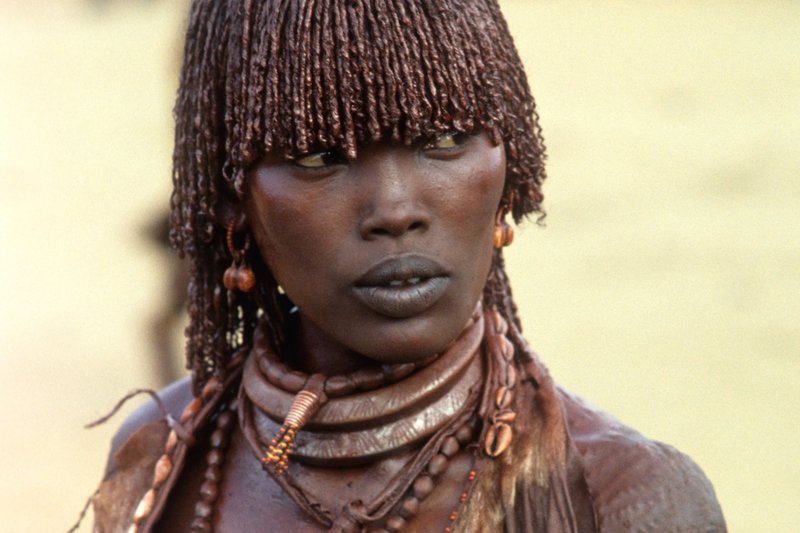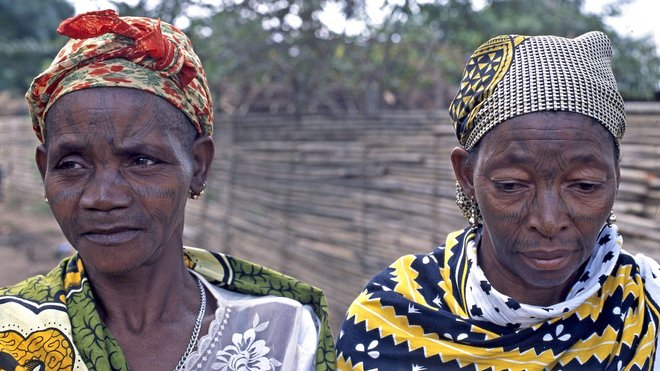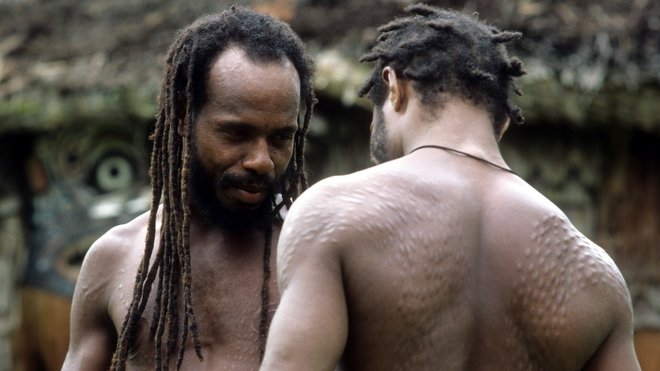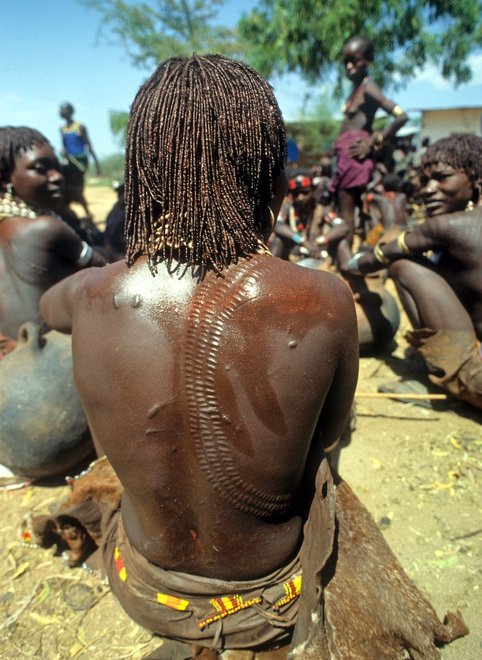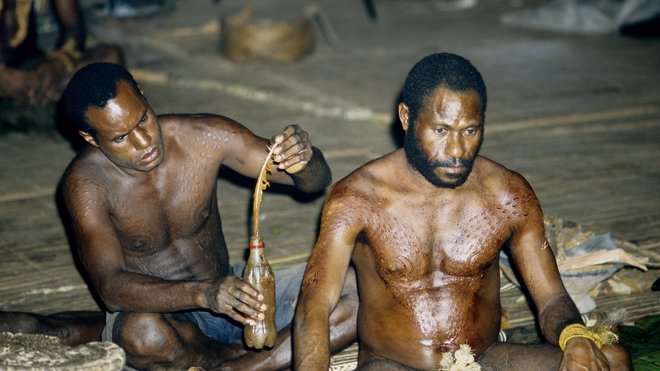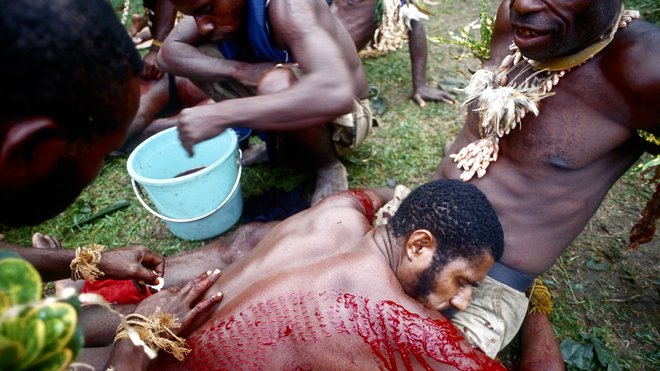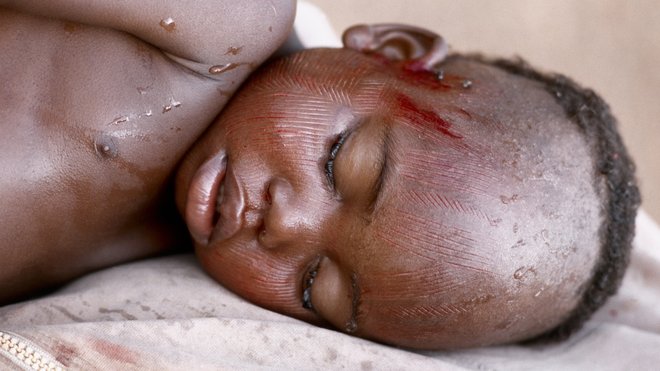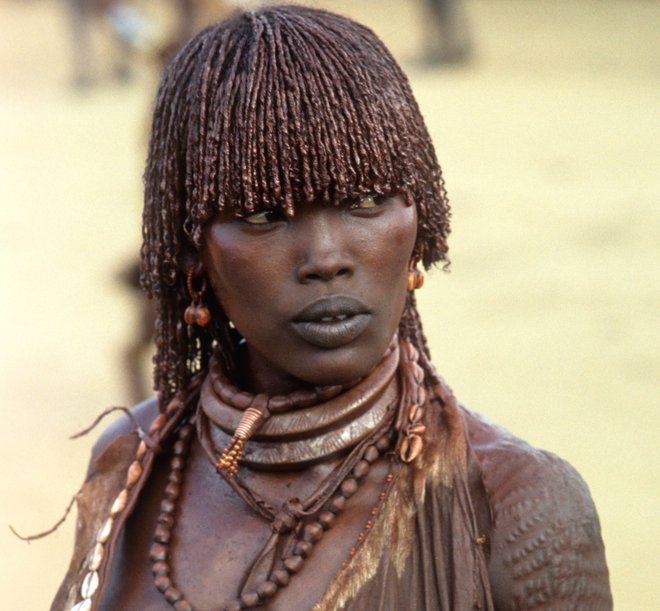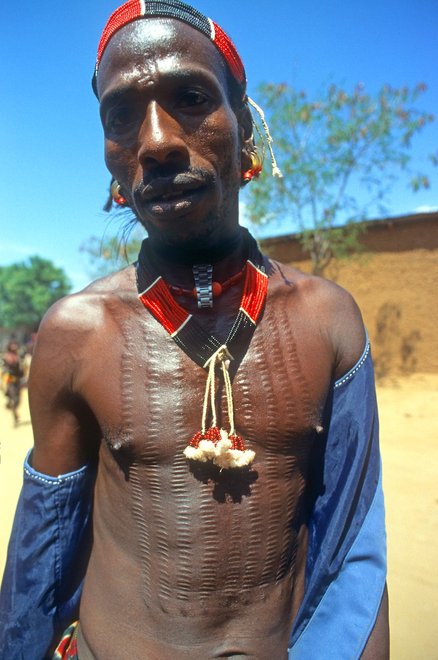Natural Canvas
Lars Krutak's research gets under the skin: the U.S. tattoo anthropologist has been studying indigenous tribes and their dwindling rituals of tattoo and scar art for decades. Scar art, also called scarification, is a multifaceted traditional method of cutting a pattern or symbol into the skin. With scar masters from Benin, Papua New Guinea, and Ethiopia, Krutak has delved into a bloody, magical world and now invites us to share in it.
"I've never felt anything so painful."
Eva Holzinger: Do you bear scars yourself?
Lars Krutak: I have worked with three indigenous peoples that scar; the Kaningara of Papua New Guinea, the Bétamarribé of Benin and the Hamar of Ethiopia. I carry scars from all of these groups. With the Kaningara tribe, I was locked in the spirit house or haus tambaran for about four days before I was scarified. I have 450 to 500 crocodile scars all over my upper body and arms. The crocodile's eyes are right on my nipples; part of the snout is on my torso; and it's arms and claws on my upper arms.
How did you manage to cope with the pain during scarification? That must have hurt incredibly!
There are a few techniques to help you get through the ritual. You will be deprived of sleep for three to four days. At night, you go hiking. When you fall asleep, they hit you on the head with a flashlight or a stick. At the time of scarification, you are so exhausted that you don't even feel the first 50 to 60 cuts. But then your body wakes up.
And then ...?
I have been poked with nails in Indonesia, needles in Borneo, thorns in the Philippines, and hippo teeth in Hawaii, and I have never felt anything as painful as I do at this moment! I tried to distract myself with nice thoughts; thoughts of my family, my wife or a refreshing cold shower because it was so hot - it felt like my chest was on fire!
As a tattoo anthropologist, you have published countless books and articles on permanent body modification. One of them is the German and English text Spiritual Skin: MAGICAL TATTOOS AND SCARIFICATION from 2012. What makes skin so magical for you?
The skin is the largest organ of the body. It protects us, keeps our organs in tact, it holds us together in the truest sense. But it is also our personal canvas on which we can immortalize thoughts and motifs. Body painting, tattoos, scars: All these signs of the skin tell personal stories. They are signatures of life. They show our longings and fears, they define who we are.
We get to know ourselves through these skin markings. Even when we don't speak, they speak for us. They speak with their own voice.
You have traveled a lot. Which indigenous tribe, which ritual impressed you the most?
The Kaningara tribe living in the Blackwater Lakes region near the Middle Sepik River of Papua New Guinea. Most fascinating to me are the initiation ceremonies for young men that take place in the Haus Tambaran - the "spirit house." Scarification is a part of it. This involves replicating the skin of a local crocodile spirit who promised the Kaningara power of over enemies.
"The skin is a natural canvas."
Is scarification mostly about becoming a man?
First and foremost, it's about becoming a human being. I also visited the Bétamarribé people in Benin. When a boy or girl is two or three years old, an intricate series of lines, ancestral symbols, are cut into their faces with an iron tool made by the village blacksmith. If they have not received these markings and die before then, they are not considered a member of the community and are not buried in the cemetery. So it's about tribal identity, about being rooted to a particular culture, a territory, and its ancestors.
Krutak explains that the word Bétamarribé translates as "the true builders of the earth," referring, among other things, to their agricultural skills. The furrows that the Bétamarribé cut into the earth are symbolically related to the fine facial and body scars that are cut into the skin. Similar marks, called ikerii ("scars of the house"), are also made on the interior and exterior walls of their homes. All of these marks, whether cut into the earth, the house, or the human skin, are associated with the Bétamarribé goddess Butan, who rules the earth and the underworld and controls human and agricultural fertility.
"It's about tribal identity, crocodile spirits and scar masters".
How do young men prepare for scarification?
In the case of the male Kaningara, this is a lengthy process. The actual scarification is preceded by a two-month enclosure in the spirit house. The young men are fattened up with fish and certain vegetables because - so the belief - the crocodile spirits eat the boys during circumcision and spit them out again as adult men.
Why are they fattened up?
The extra layer of fat they have put on also allows the scar master to work faster: He presses in a fold of skin and then cuts it, while at the same time numbing the puncture wounds to a certain degree.
Another rule is that you are not allowed to leave the spirit house, unless you need the bathroom and are covered and escorted outside by a male elder, or only in a few cases, even to see women is strictly forbidden. The brothers of their parents whisper to the men stories about the ancestors of the tribe and spiritual. In this way, they gain a deep knowledge of the beliefs and myths of their ancestors.
How long does it take and what is used to cut into the skin?
The ritual takes place every four to five years. The initiates can be between twelve and thirty- five years old, this is sometimes because the ritual is very expensive and families sometimes have to save for many years to pay for it. Scarification itself never lasts more than a day and is done all over the body with a disposable razor blade. In the past, bamboo knives were used, but they get dull very quickly and the risk of infection is higher.
Do things sometimes go wrong?
Symbolically speaking, this act is necessary to completely separate the young men from the mother and instead fill them with the power of the crocodile spirit.
"The scars are intentionally infected."
How do you make them look so beautiful afterwards?
After scarification, they sit together by the fire to dry the wounds. The skin of the young men is "smoked", so to speak. The scars are treated with homemade medicinal ointments and the oil of the kaumever tree, which is used to make war canoes. However, the scars are also intentionally infected. During the healing process, people regularly go to the river, tear the scars and rub them with the river mud. Tannin and other organic chemicals then create the three-dimensional, scaled scars that resemble the skin of a crocodile.
If scarification were possible without pain, would it still serve its purpose?
Body painting does not produce pain, and in other indigenous peoples it performs similar functions to scarification. So no, not all body modification is about pain. But the pain is not unimportant; it is a physical - and usually quite bloody - test. The pain ensures that you will never forget who you were before scarification and who you are after you receive your ancestral markings.
Don't you romanticize it a little bit, isn't there a peer pressure and a kind of submission associated with it?
Not necessarily, many Kaningara are scarified only when they have enough money. In fact, many young people choose not to do so today. It is a ceremony, one of several opportunities to show the wealth of the family. With the Bétamarribé it is different.
Nowadays, according to Krutak, the ritual of scarification is losing more and more of its spiritual meaning, as modernity and economic conditions remove it from its mythical past. Thus, initiation is no longer mandatory to "become a man," and it is very costly: a family must pay for two months of food, water, cooking, and then for the cutting itself. In the Blackwater region of the Kaningara, there are very few opportunities to earn money, except when tourists visit three or four times a year and the locals sell carvings and sometimes family heirlooms.
However, two- or three-year-old children cannot decide for themselves whether they want to receive these scars or not?!
I think that's okay. There are not only tribal identification scars, but also medical scars that are intentionally inflicted on children at regular intervals on different parts of the body. These are very small marks to relieve pain during teething, for example; adults also get such scars for back pain or other problems. So scars are not only a cultural protocol, but also a kind of spiritual medicine. There are even biomedical studies that have shown that children who are artificially stressed by such hardening practices derive medical benefits: it's like a kind of vaccination, stimulates the immune system, strengthens resistance.
" Scars are a kind of spiritual medicine."
Scarification as a healing method...
Yes, and I don't just mean the scars themselves. The medicinal plants and herbs that are used in the process of scarification have not yet been identified or studied in detail. They could be
the next cure for cancer or Alzheimer's, but we don't know because the Western world has no interest in it.
Does the scarification process differ between men and women?
This varies from tribe to tribe. As a rule, it is prescribed which patterns indigenous women and men can and cannot receive. These go back to the laws of the ancestors. Among the Kaningara, however, both men and women receive the crocodile scars, for example; the process is ritualized in the same way for women, but on a smaller scale and over a shorter period of time.
Among the tribe in Benin, scar masters have the motif determined by an oracle by throwing five cowrie shells into a ceramic pot filled with water. The ancestors observe this ceremony; they channel the forces into the oracle and thus decide on the pattern.
Among the male Hamar, scarification proves success in battle. The scars, according to Krutak, make them known to their enemies as "killers." Depending on the number of enemies killed, the Hamar warrior can have vertical rows of so-called pala or "hero" scars carved on his chest. The scar master, who is invariably female, cuts a small branch from the thorny dili bush. The double thorn is used to lift the skin, which is then cut with the iron tool ground on a stone.
Scarification in the West - Cultural Appropriation or Appreciation?
Scarification has been around for thousands of years. It has cultural and spiritual significance. I believe that there are many people who feel that our present time is a cultural wasteland. They want something ancient, real; the rootedness and spirituality of the scarification tradition attracts them. Other people are also simply looking for a psychological and physical test: to endure the pain, to transcend the body, to make the journey into another worldly existence. There are individual motivations, and I think they are all valid. I just think it's important not to copy a tribal character.
How do the tribes themselves view this affinity?
Scarification is not yet as widespread in the West as indigenous tattoo art, so for now I can only speak of the latter. I work with various indigenous female tattoo artists; they travel to international conventions and design traditional iconography for tourists that fit their individual histories and motifs. Women artists are culturally responsible and know what an outsider may or may not receive.
Scarification in Europe: The "Schmiss" of the right-wing fraternities spontaneously comes to mind. Can one compare these scars?
I would not describe a smite as scarification. I think the same applies to self-flagellation for religious reasons. However, I have hardly dealt with scarification in Europe so far. I only know that there is an old tradition of pilgrim tattoos. As early as the 1500s, visitors to the Holy Land often had a Christian tattoo symbol engraved to commemorate their visit, especially the Jerusalem cross.
"To be scarred for life": Scars are associated with stereotypes that are also expressed in entertainment literature. Disfiguring facial scars can mark a character as evil; think of Heath Ledger's Joker, whose scars on his cheeks disfigure his face into a grinning grimace.
"Looking into the past, back to our ancestors."
Your message if the whole world was listening to you right now?
Ötzi, the Iceman, had tattoos that were probably carved into his skin. This is a form of scarification. This tradition is one of the oldest cultural practices in the world. It is part of human history, one that connects us all. We need to look to the past, to our ancestors, to understand where we are going.
Thank you very much for the interview!
Lars Krutak (b. 1971 in Lincoln) is a U.S. anthropologist, photographer, and writer best known for his research on tattoo art and its cutlurean background. In 2009, he received his PhD from the School of Human Evolution & Social Change at Arizona State University. Krutak began tattoo research in 1996 as a doctoral student at the University of Alaska Fairbanks. Trained as an archaeologist and cultural anthropologist, he spent three years researching the complex symbolism and practice of tattooing in the Arctic.
Krutak's tattoo research culminated in an unpublished master's thesis, One Stitch at a Time: Ivalu and Sivuqaq Tattoo, which focuses on the traditional tattooing of the St. Lawrence Island Yupiit, as well as several freelance photojournalism assignments for leading tattoo magazines in Germany, England and the United States, for which Krutak continues to write. Today, Krutak also writes articles for other international tattoo publications, including Total Tattoo (UK), Tattoo Savage (USA), Z Tattoo (Denmark), Tattoo Magazine (Hungary) and Tattoo Planet (Netherlands).
In 2002, Krutak embarked on a world tour to record the lives, stories and experiences of tattooed people around the globe. To date, many more trips and publications have followed.
Krutak is also active outside of tattoo research: from 1999 to 2014, Krutak worked as an archaeologist and repatriation officer at the National Museum of the American Indian and National Museum and Natural History, facilitating the return of human remains, funerary objects, sacred and ceremonial objects. Today, he is a research associate at the Museum of International Folk Art.
Kalinga Tattoo: Ancient and Modern Expressions of the Tribal. Edition Reuss, Aschaffenburg 2010.
Spiritual Skin: Magical Tattoos and Scarification, Edition Reuss, Aschaffenburg 2012.
Tattoo Traditions of Native North America: Ancient and Contemporary Expressions of Identity. LM PUBLISHERS 2014.
Ancient Ink: The Archaeology of Tattooing. University of Washington Press 2017.

